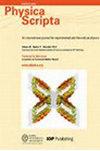基于 Cs2TiX6 的单卤化物双包晶太阳能电池的结构和光电特性比较研究:计算和实验方法
IF 2.6
3区 物理与天体物理
Q2 PHYSICS, MULTIDISCIPLINARY
引用次数: 0
摘要
这项研究工作是对 Cs2TiX6 单卤化物包晶太阳能电池(PSC)的结构、光学和电子特性进行比较研究。整个研究工作都是在环境条件下通过实验进行的,并采用了 DFT 方法。吸收材料的结构参数(晶格常数、形状)和带隙能可以很容易地通过 DFT 方法估算出来,并与实验结果进行比较。我们的研究表明,Cs2TiBr6 PSC 的带隙能为 1.80 eV(数值)和 1.82 eV(实验),开路电压为 0.58 V,短路电流为 2.55 mA cm-2,具有较好的光伏应用性能。此外,与 Cs2TiI6、Cs2TiCl6 和 Cs2TiF6 PSC 相比,Cs2TiBr6 PSC 的 Zeta 电位值更高,表明其材料稳定性更好,挥发性更低。活性层的 TEM 图像和 SAED 图样显示,PSCs 的结晶度更高。另一方面,所研究的 Cs2TiBr6、Cs2TiI6、Cs2TiCl6 和 Cs2TiF6 PSC 材料在 358 nm、375 nm、363 nm 和 735 nm 波长处显示出可见光发射边缘,Cs2TiBr6、Cs2TiI6、Cs2TiCl6 和 Cs2TiF6 样品的光学性能区域分别记录到 700 nm、760 nm、540 nm 和 660 nm 波长。本文章由计算机程序翻译,如有差异,请以英文原文为准。
Comparative study of structural, opto-electronic properties of Cs2TiX6-based single halide double perovskite solar cells: computational and experimental approach
This research work represents a comparative study of the structural, optical, and electronic properties of Cs2TiX6 single halide perovskite solar cell (PSC). The entire work has been carried out by experimental work under ambient conditions and followed by the DFT method. Absorbing material structural parameters (lattice constant, shape), and band gap energy can be easily estimated from the DFT approach which can be compared with the result of experimental work. Our study shows Cs2TiBr6 PSC has better band gap energy of 1.80 eV (numerically) and 1.82 eV (experimentally), open circuit voltage 0.58 V, short circuit current 2.55 mA cm−2 for the photovoltaic application. Also, the higher Zeta potential value of Cs2TiBr6 PSC indicates that it has better material stability and is less volatile compared to Cs2TiI6, Cs2TiCl6, and Cs2TiF6 PSCs. TEM images and the SAED pattern of the active layers show a higher degree of crystallite nature of the PSCs.On the other look, investigated PSC materials Cs2TiBr6, Cs2TiI6, Cs2TiCl6, and Cs2TiF6 have shown visible light emission edges at 358 nm, 375 nm, 363 nm, 735 nm wavelength, and the optical performance area of the Cs2TiBr6, Cs2TiI6, Cs2TiCl6, Cs2TiF6 samples is recorded up to 700 nm, 760 nm, 540 nm, and 660 nm wavelength, respectively.
求助全文
通过发布文献求助,成功后即可免费获取论文全文。
去求助
来源期刊

Physica Scripta
物理-物理:综合
CiteScore
3.70
自引率
3.40%
发文量
782
审稿时长
4.5 months
期刊介绍:
Physica Scripta is an international journal for original research in any branch of experimental and theoretical physics. Articles will be considered in any of the following topics, and interdisciplinary topics involving physics are also welcomed:
-Atomic, molecular and optical physics-
Plasma physics-
Condensed matter physics-
Mathematical physics-
Astrophysics-
High energy physics-
Nuclear physics-
Nonlinear physics.
The journal aims to increase the visibility and accessibility of research to the wider physical sciences community. Articles on topics of broad interest are encouraged and submissions in more specialist fields should endeavour to include reference to the wider context of their research in the introduction.
 求助内容:
求助内容: 应助结果提醒方式:
应助结果提醒方式:


